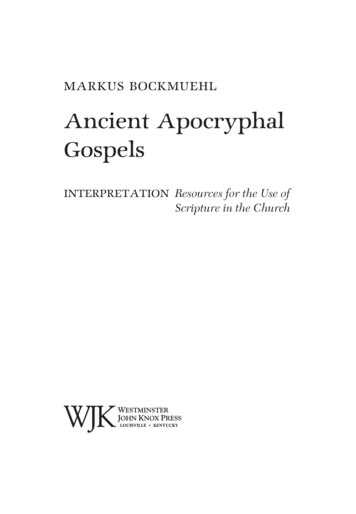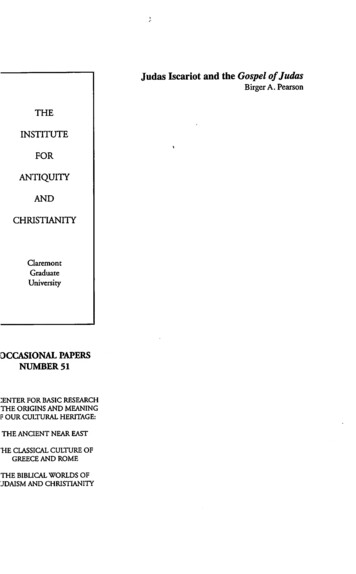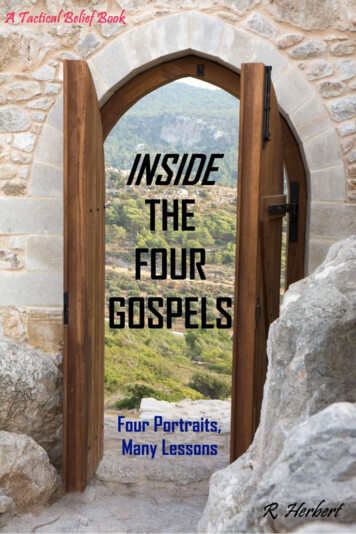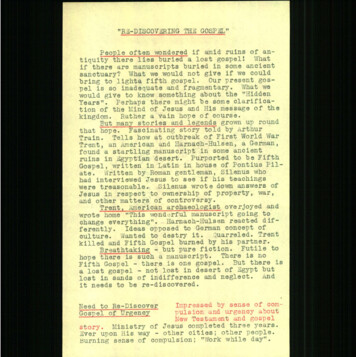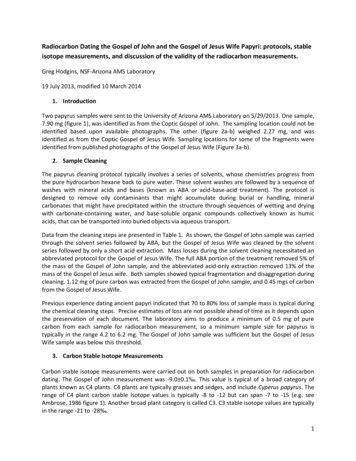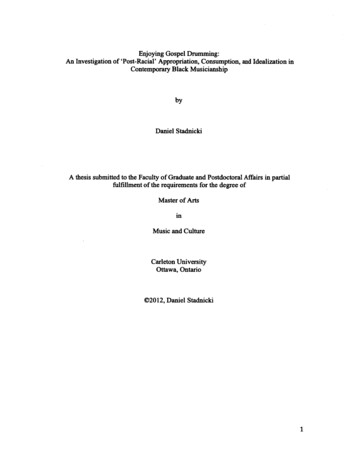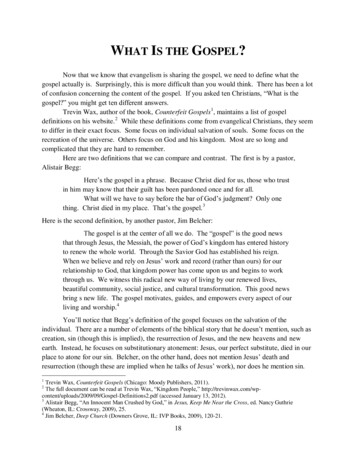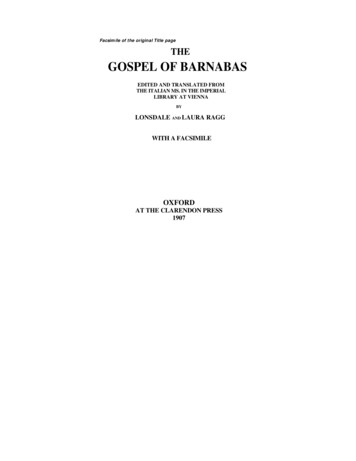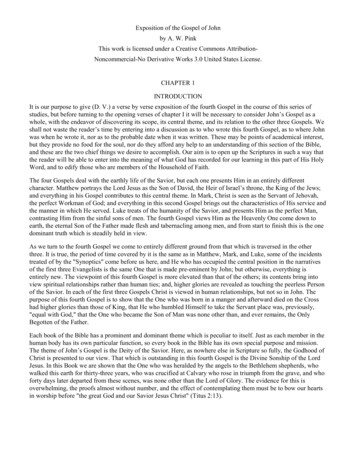
Transcription
Exposition of the Gospel of Johnby A. W. PinkThis work is licensed under a Creative Commons AttributionNoncommercial-No Derivative Works 3.0 United States License.CHAPTER 1INTRODUCTIONIt is our purpose to give (D. V.) a verse by verse exposition of the fourth Gospel in the course of this series ofstudies, but before turning to the opening verses of chapter I it will be necessary to consider John’s Gospel as awhole, with the endeavor of discovering its scope, its central theme, and its relation to the other three Gospels. Weshall not waste the reader’s time by entering into a discussion as to who wrote this fourth Gospel, as to where Johnwas when he wrote it, nor as to the probable date when it was written. These may be points of academical interest,but they provide no food for the soul, nor do they afford any help to an understanding of this section of the Bible,and these are the two chief things we desire to accomplish. Our aim is to open up the Scriptures in such a way thatthe reader will be able to enter into the meaning of what God has recorded for our learning in this part of His HolyWord, and to edify those who are members of the Household of Faith.The four Gospels deal with the earthly life of the Savior, but each one presents Him in an entirely differentcharacter. Matthew portrays the Lord Jesus as the Son of David, the Heir of Israel’s throne, the King of the Jews;and everything in his Gospel contributes to this central theme. In Mark, Christ is seen as the Servant of Jehovah,the perfect Workman of God; and everything in this second Gospel brings out the characteristics of His service andthe manner in which He served. Luke treats of the humanity of the Savior, and presents Him as the perfect Man,contrasting Him from the sinful sons of men. The fourth Gospel views Him as the Heavenly One come down toearth, the eternal Son of the Father made flesh and tabernacling among men, and from start to finish this is the onedominant truth which is steadily held in view.As we turn to the fourth Gospel we come to entirely different ground from that which is traversed in the otherthree. It is true, the period of time covered by it is the same as in Matthew, Mark, and Luke, some of the incidentstreated of by the "Synoptics" come before us here, and He who has occupied the central position in the narrativesof the first three Evangelists is the same One that is made pre-eminent by John; but otherwise, everything isentirely new. The viewpoint of this fourth Gospel is more elevated than that of the others; its contents bring intoview spiritual relationships rather than human ties; and, higher glories are revealed as touching the peerless Personof the Savior. In each of the first three Gospels Christ is viewed in human relationships, but not so in John. Thepurpose of this fourth Gospel is to show that the One who was born in a manger and afterward died on the Crosshad higher glories than those of King, that He who humbled Himself to take the Servant place was, previously,"equal with God," that the One who became the Son of Man was none other than, and ever remains, the OnlyBegotten of the Father.Each book of the Bible has a prominent and dominant theme which is peculiar to itself. Just as each member in thehuman body has its own particular function, so every book in the Bible has its own special purpose and mission.The theme of John’s Gospel is the Deity of the Savior. Here, as nowhere else in Scripture so fully, the Godhood ofChrist is presented to our view. That which is outstanding in this fourth Gospel is the Divine Sonship of the LordJesus. In this Book we are shown that the One who was heralded by the angels to the Bethlehem shepherds, whowalked this earth for thirty-three years, who was crucified at Calvary who rose in triumph from the grave, and whoforty days later departed from these scenes, was none other than the Lord of Glory. The evidence for this isoverwhelming, the proofs almost without number, and the effect of contemplating them must be to bow our heartsin worship before "the great God and our Savior Jesus Christ" (Titus 2:13).
Here is a theme worthy of our most prayerful attention. If the Holy Spirit took such marked care to guard theperfections of our Lord’s humanity-seen for example, in the words of the angel to Mary "that Holy Thing whichshall be born of thee," "made in the likeness of sin’s flesh," etc.—equally so has the Inspirer of the Scriptures seento it that there is no uncertainty touching the Divine Sonship of our Savior. Just as the Old Testament prophetsmade known that the Coming One should be a Man, a perfect Man, so did Messianic prediction give plainintimation that He should be more than a man. Through Isaiah God foretold, "For unto us a Child is born, unto us aSon is given: and the government shall be upon His shoulder: and His name shall be called Wonderful, Counseller,The Mighty God, The Everlasting Father, The Prince of Peace." Through Micah He declared, "But thou, BethlehemEphratah, though thou be little among the thousands of Judah yet out of thee shall he come forth unto me that is tobe Ruler in Israel; Whose goings forth have been from the days of eternity." Through Zechariah He said, "Awake,O Sword, against my Shepherd, and against the man that is my Fellow, saith the Lord of Hosts: smite the Shepherd,and the sheep shall be scattered." Through the Psalmist He announced, "The Lord said unto my Lord, Sit thou atmy right hand, until I make thine enemies thy footstool." And again, when looking forward to the second advent,"Thou art my Son; this day have I begotten thee (or, ‘brought thee forth’)." In these days of wide-spread departurefrom the faith, it cannot be insisted upon too strongly or too frequently that the Lord Jesus is none other than theSecond Person of the blessed Trinity, co-eternal and co-equal with the Father and the Holy Spirit.In keeping with the special theme of this fourth Gospel, it is here we have the full unveiling of Christ’s Divineglories. It is here that we behold Him dwelling with God before time began and before ever the creature wasformed (John 1:1, 2). It is here that He is denominated "The only begotten of the Father, full of grace and truth"(John 1:14). It is here we read of John the Baptist bearing record "that this is the Son of God" (John 1:34). It is herethat we read "This beginning of miracles did Jesus in Cana of Galilee, and manifested forth his glory" (John 2:11).It is here we are told that the Savior said "Destroy this temple, and in three days I will raise it up" (John 2:19). It ishere we learn that "The Father loveth the Son, and hath given all things into his hand" (John 3:35). It is in thisGospel we hear Christ saying, "For as the Father raiseth up the dead, and quickeneth them; even so the Sonquickeneth whom he will. For the Father judgeth no man, but hath committed all judgment unto the Son: that allshould honor the Son, even as they honor the Father" (John 5:21-23). It is here we find Him declaring, "BeforeAbraham was, I am" (John 8:58). It is here He affirmed "I and my Father are One" (John 10:30). It is here Hetestifies "He that hath seen me hath seen the Father" (John 14:9).Before we take up John’s Gospel in detail, a few words should also be said concerning the scope of the fourthGospel. It must be evident at once that this is quite different from the other three. There, Christ is seen in humanrelationships, and as connected with an earthly people; but here He is viewed in a Divine relationship, and asconnected with a heavenly people. It is true the mystery of the "Body" is not unfolded here—that is found only inwhat the Apostle Paul wrote as he was moved by the Holy Spirit—rather is it the Family relationship which is herein view: the Son of God together with the sons of God. It is also true that the "heavenly calling," as such, is notfully unfolded here, yet are there plain intimations of it, as a careful study of it makes apparent. In the first threeGospels Christ is seen connected with the Jews, proclaiming the Messianic kingdom, a proclamation which ceased,however, as soon as it became evident that the nation had rejected Him. But here in John’s Gospel His rejection isanticipated from the beginning, for in the very first chapter we are told, "He came unto his own, and his ownreceived him not." The limitations which obtain in connection with much which is found in the first three Gospelsdoes not, therefore, obtain in John’s. Again, in John’s Gospel the Savior is displayed as the Son of God, and assuch He can be known only by believers. On this plane, then, the Jew has no priority. The Jew’s claim upon Christwas purely a fleshly one (arising from the fact that He was "the Son of David"), whereas believers are related to theSon of God by spiritual union.As there may be some of our readers who have been influenced by ultra-dispensational teaching we deem it well tohere call attention to other points which help to fix the true dispensational bearings and scope of this fourthGospel. There are those who make no distinction between John’s Gospel and the Synoptics, and who insist thatthis fourth Gospel is entirely Jewish, and has nothing but a remote application to believers of the presentdispensation. But this, we are assured, is a serious mistake. John’s Gospel, like his Epistles, concerns the family ofGod. In proof of this we request the reader to weigh carefully the following points:
First, in John 1:11-13 we read, "He came unto his own, and his own received him not. But as many as receivedhim, to them gave he power to become the sons of God, even to them that believe on his name; which were born,not of blood, nor of the will of the flesh, nor of the will of man, but of God."From these verses we may notice three things: first, the Jews as a nation rejected the Sent One of the Father, they"received him not;" second, a company did "receive him," even those that "believed on his name"; third, thiscompany are here designated "the sons of God," who were "born . . . of God." There is nothing which in any wiseresembles this in the other Gospels. Here only, in the four Gospels, is the truth of the new birth brought before us.And it is by new birth we enter the family of God. As, then, the family of God reaches out beyond Jewishbelievers, and takes in all Gentile believers too, we submit that John’s Gospel cannot be restricted to the twelvetribed people.Second, after stating that the Word became flesh and tabernacled among us, "and we beheld his glory, the glory asof the only begotten of the Father (which is a glory that none but believers behold!), full of grace and truth," andafter summarizing John the Bapist’s witness to the Person of Christ, the Holy Spirit through the Evangelist goes onto say, "and of his fulness have all we received, and grace for grace. Surely this verse alone establishes the point ofwho it is that is here being addressed. The Jewish nation never received "of his fulness"—that can be predicated ofbelievers only. The "all we" of verse 16 is the "as many as" received Him, to them gave He power to become "thesons of God" of verse 12.Third, in the tenth chapter of John, we read that the Savior said, "I am the good shepherd, and know my sheep, andam known of mine. As the Father knoweth me, even so know I the Father: and I lay down my life for the sheep"(verses 14, 15). Immediately following this He went on to say, "And other sheep I have, which are not of this fold;them also I must bring, and they shall hear my voice, and there shall be one fold, and one shepherd" (verse 16).Who were these "other sheep?" Before we can answer this, we must ascertain who were the "sheep" referred to byChrist in the first fifteen verses of this chapter. As to who they were there can be only one answer: they were notthe nation of Israel as such, for they had "received him not"; no, they were the little company who had "receivedhim," who had "believed on his name." But Christ goes on to speak of a future company of believers, "other sheepI have (speaking as God who calleth those things which be not as though they were: Romans 4:17), them also Imust bring." Clearly, the "other sheep" which had not been brought into the fold at the time the Savior then spake,were believers from among the Gentiles, and these, together with the Jewish believers, should be "one fold" (or,better "one flock"), which is the equivalent of one family, the family of God.Fourth, in John 11:49-52 we read, "and one of them, named Caiaphas, being the high priest that same year, saidunto them, Ye know nothing at all, nor consider that it is expedient for us, that one man should die for the people,and that the whole nation perish not. And this spake he not of himself: but being high priest that year, heprophesied that Jesus should die for that nation, and not for that nation only, but that also he should gathertogether in one the children of God that were scattered abroad." This was a remarkable prophecy, and contained farmore in it than Caiaphas was aware. It made known the Divine purpose in the death of the Savior and revealedwhat was to be the outcome of the great Sacrifice. It looked out far beyond the bounds of Judaism, including withinits range believing sinners from the Gentiles. The "children of God that were scattered abroad" were the electfound among all nations. That they were here termed "children of God" while viewed as still "scattered abroad,"gives us the Divine viewpoint, being parallel with "other sheep I have." But what we desire to call special attentionto is the declaration that these believers from among the Gentiles were to be "gathered together in one," not intoone "body" (for as previously said, the body does not fall within the scope of John’s writings), but one family, thefamily of God.Fifth, in John 14:2, 3 we read that Christ said to His disciples, "In My Father’s house are many mansions: if it werenot so, I would have told you. I go to prepare a place for you. And if I go and prepare a place for you, I will comeagain and receive you unto myself that where I am, there ye may be also." How entirely different this is fromanything that is to be found in the first three Gospels scarcely needs to be pointed out. In them, reference isinvariably made to the coming of "the Son of man," but here it is the rapture of the saints to heaven, and the takingof them to be where Christ now is that is expressly mentioned. And manifestly this can in no wise be limited toJewish believers.
Sixth, without attempting to develop this point at any length it should be noticed that the relation which the HolySpirit sustains to believers in this Gospel is entirely different from what is before us in the first three. Here only dowe read of being "born of the Spirit" (John 3:5). Here only is He denominated their "Comforter’’ or Advocate(John 14:16); and here only do we read of Him "abiding forever" with believers (John 14:16).Seventh, the High Priestly prayer of the Savior which is recorded in John 17, and found nowhere else in theGospels, shows plainly that more than Jewish believers are here contemplated, and evidences the wider scope ofthis fourth Gospel. Here we find the Savior saying, "Father, the hour is come; glorify thy Son, that thy Son alsomay glorify thee: as thou hast given him power over all flesh, that he should give eternal life to as many as thouhast given him." The "as many as thou hast given him" takes in the whole family of God. Again, in verse 20 theLord Jesus says, "Neither pray I for these alone, but for them also which shall believe on me through their word:"the "these" evidently refers to Jewish believers, while the "them also" looked forward to Gentile believers. Finally,His words in verse 22, "and the glory which thou gavest me I have given them; that they may be one, even as weare one" shows, once more, that the whole family of God was here before Him.In bringing this chapter to a close we want to prepare the reader for the second of the series. In the next chapter weshall (D.V.) take up the first section of the opening chapter, and it is our earnest desire that many of our readerswill make these verses the subject of prayerful study and meditation. The Bible teacher who becomes a substitutefor diligent study on the part of those who hear him is a hindrance and not a help. The business of the teacher is toturn people to the searching of the Scriptures for themselves, stimulating their interest in the Sacred Word, andinstructing them how to go about it. With this end in view, it will be our aim to prepare a series of questions at theclose of each chapter bearing on the passage to be expounded in the succeeding one, so that the reader may study itfor himself. Below are seven questions on the passage for the portion we shall take up in the next lesson, and weearnestly urge our readers to study the first thirteen verses of John 1, and to concentrate upon the points raised byour questions.1. What "beginning" is referred to in John 1:1?2. How may I obtain a better, deeper, fuller knowledge of God Himself? By studying nature? By prayer? Bystudying Scripture? Or—how?3. Why is the Lord Jesus here termed "The Word?" What is the exact force and significance of this title?4. What is the meaning of John 1:4—"The Life was the Light of men?"5. The fact that the Savior is termed "the Light" in John 1:7, teaches us what?6. What does John 1:12 teach concerning what a sinner must do to be saved?7. What is the exact meaning of each clause in John 1:13?Pray over and meditate much upon each of these questions, and above all "Search the Scriptures" to find God’sanswers. Answers to these questions will be found in the next chapter, in the course of our exposition of John 1:113.
Exposition of the Gospel of JohnCHAPTER 2Christ, the Eternal WordJohn 1:1-13In the last chapter we stated, "Each book of the Bible has a prominent and dominant theme which is peculiar to itself.Just as each member in the human body has its own particular function, so, every book in the Bible has its own specialpurpose and mission. The theme of John’s Gospel is the Deity of the Savior. Here, as nowhere else in Scripture so fully,the Godhood of Christ is presented to our view. That which is outstanding in this fourth Gospel is the Divine Sonshipof the Lord Jesus. In this book we are shown that the One who was heralded by the angels to the Bethlehem shepherds,who walked this earth for thirty-three years, who was crucified at Calvary, who rose in triumph from the grave, andwho forty days later departed from these scenes, was none other than the Lord of glory. The evidence for this isoverwhelming, the proofs almost without number, and the effect of contemplating them must be to bow our hearts inworship before ‘the great God and our Savior Jesus Christ’ (Titus 2:13)."That John’s Gospel does present the Deity of the Savior is at once apparent from the opening words of the first chapter.The Holy Spirit has, as it were, placed the key right over the entrance, for the introductory verses of this fourth Gospelpresent the Lord Jesus Christ in Divine relationships and unveil His essential glories. Before we attempt an expositionof this profound passage we shall first submit an analysis of its contents. In these first thirteen verses of John 1 we haveset forth: —1. The Relation of Christ to Time—"In the beginning," therefore, Eternal: John 1:1.2. The Relation of Christ to the Godhead—"With God," therefore, One of the Holy Trinity: John 1:1.3. The Relation of Christ to the Holy Trinity—"God was the Word"—the Revealer: John 1:1.4. The Relation of Christ to the Universe—"All things were made by him"—the Creator: John 1:3.5. The Relation of Christ to Men—Their "Light": John 1:4, 5.6. The Relation of John the Baptist to Christ—"Witness" of His Deity: John 1:6-9.7. The Reception which Christ met here: John 1:10-13.(a) "The world knew him not": John 1:10.(b) "His own (Israel) received him not": John 1:11.(c) A company born of God "received him": John 1:12, 13."In the beginning was the word, and the word was with God, and the word was God. The same was in the beginningwith God. All things were made by him; and without him was not anything made that was made" (John 1:1-3). Howentirely different is this from the opening verses of the other Gospels! John opens by immediately presenting Christnot as the Son of David, nor as the Son of man, but as the Son of God. John takes us back to the beginning, and showsthat the Lord Jesus had no beginning. John goes behind creation and shows that the Savior was Himself the Creator.Every clause in these verses calls for our most careful and prayerful attention."In the beginning was the word, and the word was with God, and the word was God." Here we enter a realm whichtranscends the finite mind, and where speculation is profane. "In the beginning" is something we are unable tocomprehend: it is one of those matchless sweeps of inspiration which rises above the level of human thought. "In thebeginning was the word," and we are equally unable to grasp the final meaning of this. A "word" is an expression: bywords we articulate our speech. The Word of God, then, is Deity expressing itself in audible terms. And yet, when we
have said this, how much there is that we leave unsaid! "And the word was with God," and this intimates His separatepersonality, and shows His relation to the other Persons of the blessed Trinity. But how sadly incapacitated are we formeditating upon the relations which exist between the different Persons of the Godhead. "And God was the word." Notonly was Christ the Revealer of God, but He always was, and ever remains, none other than God Himself. Not onlywas our Savior the One through whom, and by whom, the Deity expressed itself in audible terms, but He was Himselfco-equal with the Father and the Spirit. Let us now approach the Throne of grace and there seek the mercy and gracewe so sorely need to help us as we turn now to take a closer look at these verses."Our God and Father, in the name of Thy dear Son, we pray Thee that Thy Holy Spirit may now take of the things ofChrist and show them unto us: to the praise of the glory of Thy grace. Amen.""In THE BEGINNING," or, more literally, "in beginning," for there is no article in the Greek. In what "beginning?"There are various "beginnings" referred to in the New Testament. There is the "beginning" of "the world" (Matthew24:21); of "the gospel of Jesus Christ" (Mark 1:1); of "sorrows" (Mark 13:8); of "miracles" (or "signs"), (John 2:11),etc. But the "beginning" mentioned in John 1:1 clearly antedates all these "beginnings." The "beginning" of John 1:1precedes the making of the "all things" of John 1:3. It is then, the beginning of creation, the beginning of time. Thisearth of ours is old, how old we do not know, possibly millions of years. But "the word" was before all things. He wasnot only from the beginning, but He was "in the beginning.""In beginning:" the absence of the definite article is designed to carry us back to the most remote point that can beimagined. If then, He was before all creation, and He was, for "all things were made by him;" if He was "in thebeginning," then He was Himself without beginning, which is only the negative way of saying He was eternal. Inperfect accord with this we find, that in His prayer recorded in John 17, He said, "And now, O Father, glorify thou mewith thine own self with the glory which I had with thee before the world was." As, then, the Word was "in thebeginning," and if in the beginning, eternal, and as none but God Himself is eternal, the absolute Deity of the LordJesus is conclusively established."WAS the word." There are two separate words in the Greek which, in this passage, are both rendered "was": the onemeans to exist, the other to come into being. The latter word (egeneto) is used in John 1:3 which, literally rendered,reads, "all things through him came into being, and without him came into being not even one (thing) which has comeinto being;" and again we have this word "egeneto" in John 1:6 where we read, "there was (became to be) a man sentfrom God, whose name was John;" and again in John 1:14, "And the word was made (became) flesh." But here in John1:1 and John 1:2 it is "the word (ito) with God." As the Word He did not come into being, or begin to be, but He was"with God" from all eternity. It is noteworthy that the Holy Spirit uses this word "ito," which signifies that the Sonpersonally subsisted, no less than four times in the first two verses of John 1. Unlike John the Baptist who "became(egeneto) a man," the "word" was (ito), that is, existed with God before time began."Was THE WORD." The reference here is to the Second Person in the Holy Trinity, the Son of God. But why is theLord Jesus Christ designated "the word?" What is the exact force and significance of this title? The first passage whichoccurs to our minds as throwing light on this question is the opening statement in the Epistle to the Hebrews: "God whoat sundry times and in divers manners spake in time past unto the fathers by the prophets, hath in these last days spokenunto us by his Son." Here we learn that Christ is the final spokesman of God. Closely connected with this is theSavior’s title found in Revelation 1:8—"I am Alpha and Omega," which intimates that He is God’s alphabet, the Onewho spells out Deity, the One who utters all God has to say. Even clearer, perhaps, is the testimony of John 1:18: "Noman hath seen God at any time; the only begotten Son, which is in the bosom of the Father, he hath declared him." Theword "declared" means tell out, cf. Acts 15:14, and 21:19; it is translated "told" in Luke 24:35. Putting together thesethree passages we learn that Christ is the One who is the Spokesman of God, and One who spelled out the Deity, theOne who has declared or told forth the Father.Christ, then, is the One who has made the incomprehensible God intelligible. The force of this title of His found inJohn 1:1, may be discovered by comparing it with that name which is given to the Holy Scriptures—"the Word ofGod." What are the Scriptures? They are the Word of God. And what does that mean? This: the Scriptures reveal God’smind, express His will, make known His perfections, and lay bare His heart. This is precisely what the Lord Jesus hasdone for the Father. But let us enter a little more into detail:—
(a) A "word" is a medium of manifestation. I have in my mind a thought, but others know not its nature. But themoment I clothe that thought in words it becomes cognizable. Words, then, make objective unseen thoughts. This isprecisely what the Lord Jesus has done. As the Word, Christ has made manifest the invisible God.(b) A "word" is a means of communication. By means of words I transmit information to others. By words I expressmyself, make known my will, and impart knowledge. So Christ, as the Word, is the Divine Transmitter, communicatingto us the life and love of God.(c) A "word" is a method of revelation. By his words a speaker exhibits both his intellectual caliber and his moralcharacter. By our words we shall be justified, and by our ‘words we shall be condemned. And Christ, as the Word,reveals the attributes and perfections of God. How fully has Christ revealed God! He displayed His power, Hemanifested His wisdom, He exhibited His holiness, He made known His grace, He unveiled His heart. In Christ, andnowhere else, is God fully and finally told out."And the word was WITH GOD." This preposition "with" seems to suggest two thoughts. First, the Word was in thepresence of God. As we read, "Enoch walked with God," that is, he lived in fellowship with God. There is a beautifulverse in Proverbs 8 which throws its light on the meaning of "with" in John 1:1, and reveals the blessed relation whichobtained from all eternity between the Word and God. The passage begins at John 8:22 where "wisdom" is personified.It tells us of the happy fellowship which existed between the Word and God before ever the world was. In John 8:30we read, "Then I was by him, as one brought up with him: and I was daily his delight, rejoicing always before him."In addition to the two thoughts just suggested, we may add that the Greek preposition "pros" here translated "with" issometimes rendered "toward," but most frequently "unto." The Word was toward or unto God. One has significantlysaid, "The word rendered with denotes a perpetual tendency, as it were, of the Son to the Father, in unity of essence."That it is here said "the word was with God" tells of His separate personality: He was not "in" God, but "with" God.Now, mark here the marvelous accuracy of Scripture. It is not said, "the word was with the Father" as we might haveexpected, but "the word was with God." The name "God" is common to the three Persons of the Holy Trinity, whereas"the Father" is the special title of the first Person only. Had it said "the word was with the Father," the Holy Spirit hadbeen excluded; but "with God" takes in the Word dwelling in eternal fellowship with both the Father and the Spirit.Observe, too, it does not say, And God was with God,"’ for while there is plurality of Persons in the Godhead, thereis but "one God," therefore the minute accuracy of "the WORD was with God.""And the word WAS GOD," or, more literally, "and God was the word." Lest the figurative expression "the word"should convey to us an inadequate conception of the Divine glories of Christ, the Holy Spirit goes on to say, "and theword was with God," which denoted His separate personality, and intimated His essential relation to the Godhead. And,as though that were not strong enough, the Holy Spirit expressly adds, "and God was the word." Who could expressGod save Him who is God! The Word was not an emanation of God, but God Himself made manifest. Not only therevealer of God, but God Himself revealed. A more emphatic and unequivocal affirmation of the absolute D
Gospel. There are those who make no distinction between John’s Gospel and the Synoptics, and who insist that this fourth Gospel is entirely Jewish, and has nothing but a remote application to believers of the present dispensation. But this, we are assured, is a serious mistake. John’s Gospel

